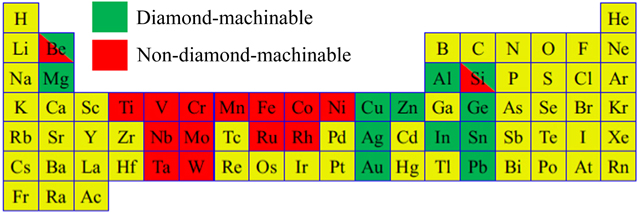- Introduction
- High Speed Steel
- Carbides
- Cermets
- Ultrahard Materials
- Powder Metallurgy Materials
- Tool Coatings
- Tool Reinforcements
Introduction
Cutting tools include those used for metal cutting and similar machining operations. Examples of these tools include:
- Drill Bits
- End Mills
- Turning tools
- Boring Bars
- Reamers
- Taps
- Broaches
Tool materials must be hard to maintain their shape, and yet be able to absorb energy of impact and vibration. The balance between hardness and toughness is at the heart of cutting tool material selection.
The most popular materials for machining cutters are high speed steel, cemented carbides, cermets, ceramics, and ultrahard materials. Among the performance characteristics of cutting tools, the tradeoff between hardness and toughness is one of the most critical. The tool materials outlined below increase in hardness from high speed steel (the softest) and increasing to PCD diamond at the high end. This increase in hardness is typically accompanied by a decrease in the toughness of the material. Additionally, the harder the materials on this list can operate at higher speeds, while the softer/tougher materials can tolerate higher feed rates (or chip loads).
High Speed Steels
When hardened steel is heated to elevated temperatures, it begins to soften. This process, known as tempering, can be useful in that it restores some toughness and usability to extremely hard steel. However, in machining applications it is essential that the tool remains hard. The heat that builds up from friction and the shearing action of the cutting process increases rapidly with increases in cutting speed.
Certain alloy additions, such as molybdenum and tungsten help to raise the temperature range at which the softening occurs. Steels with elevated levels of these elements are known as high speed steels (HSS) because of their ability to cut at higher speeds (and thus, temperatures) without softening.
To enable their initial hardening, high speed steels also contain a high concentration of carbon, and can be heat treated to a high level of hardness (relative to many other steels). Compared to other cutting tool materials, however, HSS alloy tend to be preferred in applications where their cost and toughness are primary factors. HSS Alloys are commonly used for reamers, drills, taps and some turning and milling cutters.
- T-Series
- The original HSS alloys were tungsten based.
- M-Series
- The M series HSS alloys are molybdenum based and are the most popular.
- Cobalt Additions – Some of the M series alloys include the element cobalt which increases the ability of the HSS to remain hard at elevated temperatures.
- PM HSS
- Powder metallurgy is a method of manufacturing materials by compressing powder material and
Carbides
Uncoated Carbides (HW)
Coated Carbides (HC)
The term carbide refers to a specific class of compounds with a high carbon concentration. One example is iron carbide (Fe3C) or cementite that is present in many steels and cast irons. Another common carbide is silicon carbide which is commonly used as an abrasive and in anti-slip “grip tape.”
When talking about tool materials, however, the term “carbide” usually refers to a material composed primarily of tungsten carbide (WC) particles held together by a cobalt (Co) binder. This composite structure gives the hard tungsten carbide particles a tough structure and produces an extremely versatile cutting tool material.
Cutting tools can be made from a solid carbide (WC-Co) offer a rigid, durable tool that outperforms high speed steel in terms of rigidity, cutting speed and overall hardness.
One way to categorize cutting tool materials is by their workpiece material groups (ISO 513). These groups allow a user to select a suitable cutter by the material it is intended to machine. Each material group is subdivided into more refined categories.
- P (blue) – Steel
- M (yellow) – Stainless Steel
- K (red) – Cast Iron
- N (green) – Non-Ferrous Materials
- S (brown) – Special, High-Temperature Alloys
- H (gray) – Hardened Materials
Cermets
Uncoated hard metal (HT – Titanium Carbides, Titanium Nitrides)
Coated Cermets (HC)
Cermets are a combination of ceramic and metal materials. Commonly used ceramics can be oxides, borides or carbides. These ceramic particles are bonded together using metals such as nickel, molybdenum or cobalt.
While tungsten carbide is a ceramic material, and it is normally cemented together with the metal cobalt, it is usually categorized separately from the rest of the cermet tool materials.
Ceramics
Oxide Ceramics (CA) Al204 for example
Nitride Ceramics (CN) Si3N4 for example
Coated Ceramics (CC)
Ceramic
Often used for machining superalloys
Ultrahard Tool Materials
Ultrahard tool materials include diamond and CBN
Diamond
Typically (DP) polycrystaline diamond. Diamond cutting tools are not suitable for ferrous metals, as well as certain non-ferrous metals such as Titanium, Vanadium, Cobalt and Chromium and Nickle and others.

Cubic Boron Nitride
(BN)
CBN particles often bonded with a ceramic binder
Powder Metallurgy Materials
Tool Coatings
One of the most important elements in cutting tool design is the selection of tool coatings. Coatings can provide an extremely hard and long-lasting layer with a desirable coefficient of friction over a tougher substrate. Often coatings are applied in layers.
Tool Reinforcements
SiC whisker reinforcement
References
Jiang, Guo, et al. “A Critical Review on the Chemical Wear and Wear Suppression of Diamond Tools in Diamond Cutting of Ferrous Metals.” International Journal of Extreme Manufacturing, vol. 2, no. 1, 2020, p. 012001., doi:10.1088/2631-7990/ab5d8f.


Recent Comments